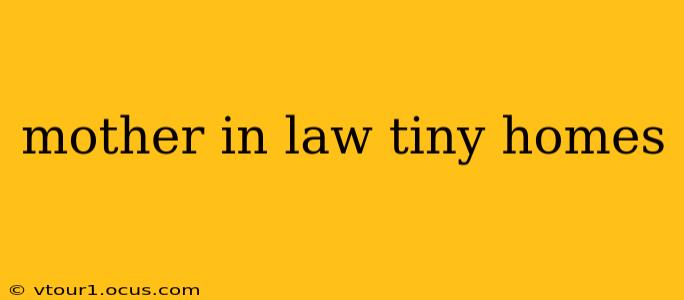Finding the perfect solution for multigenerational living can be challenging. But what if you could combine the benefits of independent living with the joys of close proximity? Enter the mother-in-law tiny home, a growing trend that offers a unique and practical approach to multigenerational housing. This guide explores the various aspects of mother-in-law tiny homes, from design considerations to legal implications, helping you determine if this is the right choice for your family.
What is a Mother-in-Law Tiny Home?
A mother-in-law tiny home, also known as a granny flat, accessory dwelling unit (ADU), or casita, is a small, independent dwelling unit located on the same property as a larger primary residence. Unlike traditional additions, these homes are often detached structures, offering residents a sense of privacy and independence while maintaining convenient access to family and support. The "mother-in-law" moniker simply refers to the common use case: providing comfortable and private living space for aging parents, adult children, or other family members.
What are the Advantages of a Mother-in-Law Tiny Home?
The benefits of a mother-in-law tiny home are numerous and extend to all family members:
- Increased Family Proximity: Enjoy the convenience of living close to loved ones without sacrificing personal space.
- Financial Assistance: Shared expenses like property taxes, utilities, and yard maintenance can lead to significant savings.
- Caregiving Support: Provides convenient access to family members who may need assistance with daily tasks or healthcare.
- Increased Property Value: Adding an ADU often significantly increases the overall value of the property.
- Generational Knowledge Transfer: Close proximity fosters stronger family bonds and facilitates the sharing of wisdom and experiences across generations.
- Rental Income Potential: If not used for family, it can be rented out for additional income.
What are the Disadvantages of a Mother-in-Law Tiny Home?
While the advantages are plentiful, it's important to consider potential drawbacks:
- Space Constraints: Tiny homes, by definition, are small. Carefully consider the needs and comfort levels of the intended resident(s).
- Potential for Conflict: Living in close proximity can sometimes lead to disagreements. Clear boundaries and communication are crucial.
- Building Costs and Regulations: Building permits, inspections, and construction costs can vary significantly depending on location and design. Understanding local zoning laws and building codes is essential.
- Loss of Yard Space: The addition of a tiny home will inevitably reduce the amount of available yard space.
- Resale Value Considerations: While generally adding value, it's important to consider if the style and size of the tiny home will appeal to future buyers.
How Much Does a Mother-in-Law Tiny Home Cost?
The cost of building a mother-in-law tiny home varies widely depending on several factors:
- Size and Features: Larger homes with more amenities will naturally be more expensive.
- Materials: The choice of building materials (e.g., wood, metal, composite) significantly impacts the cost.
- Location: Labor and material costs vary geographically.
- Construction Method: Prefabricated tiny homes are often less expensive than custom-built options.
What are the Legal Requirements for Building a Mother-in-Law Tiny Home?
Before you begin construction, it's crucial to research local zoning laws, building codes, and permitting requirements. These regulations vary considerably from place to place, and failing to comply can result in fines or even demolition. Consult your local planning department or a qualified building professional to ensure compliance.
Are there Different Types of Mother-in-Law Tiny Homes?
Yes, there are several design options to suit various needs and preferences:
- Detached Units: Separate structures offering complete privacy.
- Attached Units: Connected to the main house, offering shared amenities but less privacy.
- Converted Spaces: Existing structures on the property, such as a garage or shed, renovated into living spaces.
- Prefabricated Homes: Factory-built units delivered and assembled on-site, often quicker and more cost-effective.
How Do I Choose the Right Location for My Mother-in-Law Tiny Home?
Choosing the right location is crucial for both functionality and aesthetic appeal. Consider factors such as:
- Proximity to the main house: Balance convenience with the need for privacy.
- Access to utilities: Ensure easy access to water, electricity, and sewage.
- Sunlight and views: Optimize the location for natural light and pleasant views.
- Privacy: Choose a location that offers a degree of seclusion and quiet.
This guide provides a comprehensive overview of mother-in-law tiny homes. Remember to thoroughly research local regulations and consult with professionals to ensure a successful and enjoyable project. The careful planning and consideration of various factors will contribute to a positive and enriching multigenerational living experience.
